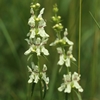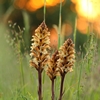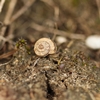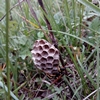Grasslands
Numbers corresponds with numbers on the board
1.
Xerothermic grasslands are thermophilic plant communities growing mainly on the sun-heated edges of river valleys. Their formation is not a completely natural process. They are present where forests were once removed and for years animals were grazed, mainly sheep. This type of extensive agriculture contributed to the settlement of dry and thermophilic vegetation, which came here from southern Europe. The edges of river valleys, especially their southern and western slopes, intensively heated by the sun, create ideal conditions for xerothermic grasslands. Grasses and herbs are the dominant vegetation of such communities. They give grasslands a characteristic steppe character. Among them there are many rare and endangered species.
In spite of their diversity, xerothermic grasslands occurring in Poland are included in the common phytosociological group and belong to protected habitats under the European Union Habitats Directive (habitat code 6210). There are four main subtypes of this habitat in Poland. These are: flowering grasslands, stipa grasslands, rock grasslands and xerothermic herbs.
How we protect them?
2.
For xerothermic grasslands associated with extensive pastoral management, grazing is the main method of protection. A common practice was grazing a mixed herd of sheep, goats, single individuals of cattle and horses. Sometimes in heavily degraded areas, grazing must be preceded by the felling of bushes and trees.
Economic changes in agriculture led to the cessation of grazing, which directly contributed to the overgrowth of grasslands with blackthorn bushes, hawthorn, wild roses, black locust, as well as blackberries and Calamagrostis grass. Currently, to preserve the undoubted value of grasslands, it is necessary to carry out active conservation measures. Therefore, since the beginning of the Station’s existence, we have introduced animal grazing here. We breed sheep and goats. These animals are not accidentally selected. Heath Sheep is an old, native breed, perfectly adapted to our climatic conditions, not very nutritiously demanding and relatively resistant to diseases. Heaths are also small, agile animals that cope well in hilly terrain such as the edges of the river valley. The protection of grasslands in the form of almost every day (from spring to autumn) grazing animals is additionally supported by clearing of bushes and single trees.
Characteristic species of flora and fauna
 Reverdin’s blue Reverdin’s blue Plebejus argyrognomon |  St Bernard’s lily St Bernard’s lily Anthericum liliago | |
 Perennial yellow-woundwort Perennial yellow-woundwort Stachys recta |  Scorzonera ScorzoneraScorzonera purpurea |  Knapweed Knapweed Orobanche lutea |
 Helicopsis striata |  European paper wasp nest |
Photos
Feather grass meadow with Stipa Joannis.
Heath sheep grazing on grasslands in Owczary.
About Heath Sheep
3.
Heath Sheep is one of many breeds of domestic sheep bred in Poland. It is a small, primitive sheepskin breed – one of the oldest native sheep breeds known from the area of today’s north-eastern Poland as early as the 17th century. They can be sheared twice a year and their wool may be gray or black. They are resistant to diseases and their meat tastes like venison. However, in the mid-1950s, the Polish population began to decline due to the displacement of this breed by merinos, who, despite less fertility, had more meat and white wool, for which there was market demand. At the beginning of the 1970s, the Institute of Animal Production began a breed reconstruction program in Poland. Currently, sheep of this breed are usually used as “live mowers” – often serving to protect nature being grazed in meadows in protected areas.













